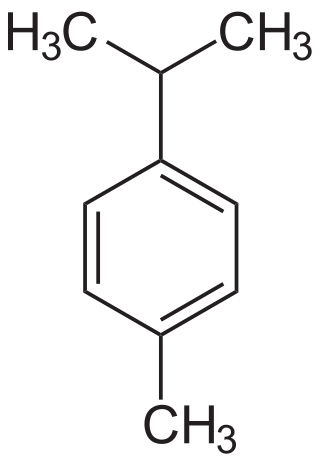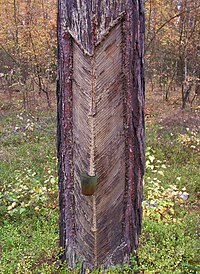
In polymer chemistry and materials science, a resin is a solid or highly viscous substance of plant or synthetic origin that is typically convertible into polymers. Resins are usually mixtures of organic compounds. This article focuses mainly on naturally occurring resins.

Coke is a grey, hard, and porous coal-based fuel with a high carbon content. It is made by heating coal or petroleum in the absence of air. Coke is an important industrial product, used mainly in iron ore smelting, but also as a fuel in stoves and forges.

Rosin, also called colophony or Greek pitch, is a solid form of resin obtained from pines and some other plants, mostly conifers, produced by heating fresh liquid resin to vaporize the volatile liquid terpene components. It is semi-transparent and varies in color from yellow to black. At room temperature rosin is brittle, but it melts at stove-top temperature. It chiefly consists of various resin acids, especially abietic acid. The term colophony comes from colophonia resina, Latin for "resin from Colophon", an ancient Ionic city. It is an FDA approved food additive.

The longleaf pine is a pine species native to the Southeastern United States, found along the coastal plain from East Texas to southern Virginia, extending into northern and central Florida. In this area it is also known as "yellow pine" or "long leaf yellow pine", although it is properly just one out of a number of species termed yellow pine. It reaches a height of 30–35 m (98–115 ft) and a diameter of 0.7 m (28 in). In the past, before extensive logging, they reportedly grew to 47 m (154 ft) with a diameter of 1.2 m (47 in). The tree is a cultural symbol of the Southern United States, being the official state tree of Alabama. This particular species is one of the eight pine tree species that falls under the "Pine" designation as the state tree of North Carolina.

Pinus rigida, the pitch pine, is a small-to-medium-sized pine. It is native to eastern North America, primarily from central Maine south to Georgia and as far west as Kentucky. It is found in environments which other species would find unsuitable for growth, such as acidic, sandy, and low-nutrient soils.

Dry distillation is the heating of solid materials to produce gaseous products. The method may involve pyrolysis or thermolysis, or it may not.

Pyrography or pyrogravure is the free handed art of decorating wood or other materials with burn marks resulting from the controlled application of a heated object such as a poker. It is also known as pokerwork or wood burning.

Pinus roxburghii, commonly known as chir pine or longleaf Indian pine, is a species of pine tree native to the Himalayas. It was named after William Roxburgh.

Tar is a dark brown or black viscous liquid of hydrocarbons and free carbon, obtained from a wide variety of organic materials through destructive distillation. Tar can be produced from coal, wood, petroleum, or peat.

"Frau Holle" is a German fairy tale collected by the Brothers Grimm in Children's and Household Tales in 1812. It is of Aarne-Thompson type 480.

Naval stores are all liquid products derived from conifers. These materials include rosin, tall oil, pine oil, and terpentine. Crude gum or oleoresin can be collected from the wounds of living pine trees.

The naval stores industry produces and markets products derived from the oleoresin of pine trees, including rosin, tall oil, pine oil, and turpentine. It does this by collecting and processing organic forest products refined from slash pine and longleaf pine trees. The naval stores industry was associated with the maintenance of the wooden ships and sailing tackle of pre-20th century navies, which were caulked and waterproofed using the pitch of the pine tree.

The Palatinate Forest, sometimes also called the Palatine Forest, is a low-mountain region in southwestern Germany, located in the Palatinate in the state of Rhineland-Palatinate. The forest is a designated nature park covering 1,771 km2 and its highest elevation is the Kalmit.

Dittweiler is an Ortsgemeinde – a municipality belonging to a Verbandsgemeinde, a kind of collective municipality – in the Kusel district in Rhineland-Palatinate, Germany. It belongs to the Verbandsgemeinde of Oberes Glantal, whose seat is in Schönenberg-Kübelberg.

A charcoal burner is someone whose occupation is to manufacture charcoal. Traditionally this is achieved by carbonising wood in a charcoal pile or kiln. Charcoal burning is one of the oldest human crafts.

Charcoal is a lightweight black carbon residue produced by strongly heating wood in minimal oxygen to remove all water and volatile constituents. In the traditional version of this pyrolysis process, called charcoal burning, often by forming a charcoal kiln, the heat is supplied by burning part of the starting material itself, with a limited supply of oxygen. The material can also be heated in a closed retort. Modern charcoal briquettes used for outdoor cooking may contain many other additives, e.g. coal.

Resin extraction consists of incising the outer layers of a pine tree in order to collect the sap or resin.

The history of Central European forests is characterised by thousands of years of exploitation by people. Thus a distinction needs to be made between the botanical natural history of the forest in pre- and proto-historical times—which falls mainly into the fields of natural history and Paleobotany—and the onset of the period of sedentary settlement which began at the latest in the Neolithic era in Central Europe - and thus the use of the forest by people, which is covered by the disciplines of history, archaeology, cultural studies and ecology.
The job of an ash burner or potash burner (Pottaschbrenner) was to burn wood for industrial purposes. From the ashes, the potash needed in dyeing, in soapmaking and in glassmaking could be made by leaching and boiling.
"Pecherei" is the common expression in southern Lower Austria for the practice of Resin Extraction from black pine trees (Evergreens). This profession centers around the extraction of tree resin, also known as "Pitch," that will ultimately be used in the production of further chemical products. Those who extract resin for a living are described as "Pecher" or "Resin Workers." In the year 2011, Pecherei was incorporated into the register of Intangible Cultural Heritage in Austria, which was drafted in the context of the UNESCO Convention for the Preservation of Intangible Culture.



















